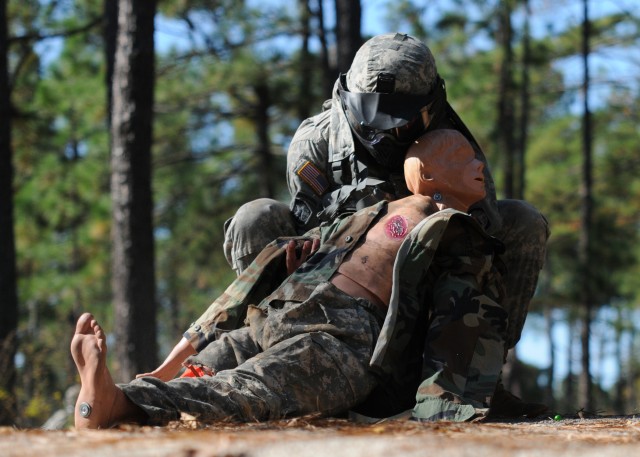
FORT BRAGG, N.C. - Soldiers need to possess a number of skills to accomplish their missions. The enemy doesn't know or care what a Soldier's job is and doesn't distinguish between an infantryman and an administrative specialist when opening fire. All Soldiers must know how to load, fire and maintain their weapons.
When a Soldier is injured and requires immediate medical care, a trained medic may not always be nearby. To serve as first responders, some Soldiers undergo combat lifesaver training to learn the medical skills necessary to treat wounds, stop bleeding and prevent shock.
Soldiers learn these skills during a four-day course containing 40 hours of training from combat medics at Fort Bragg's Medical Simulation Training Center off of Lamont Road.
In addition to the hands-on training Soldiers receive from learning how to insert an IV to controlling bleeding, they finish the training by going through a lane training exercise where opposing forces are shooting at them with paintball guns, and dummies representing fellow Soldiers with injuries must be moved to safety and treated.
Master Sgt. Lawrence Veihl, noncommissioned officer in charge of the MSTC, said the course is designed to allow the new combat lifesavers to experience some of the obstacles and injuries they may see in combat.
"They have to navigate rough terrain, rescue injured Soldiers from a disabled vehicle and operate in an urban environment," said Veihl. "They take turns treating the injured who have an amputated limb or a chest wound, all while under fire from the OPFOR. They have to not only think about what they need to do as combat lifesavers, but also about protecting themselves from enemy fire and performing all their other Soldier skills."
The students and instructors agreed about the importance of the training matching potential combat situations.
"For a lot of the CLS students, this is the most realistic training they will get. We can teach them how to apply a tourniquet in a classroom all day long, but it's remembering how to do it while under fire that's important," said Staff Sgt. Sparky Edwards, a combat medic with the 27th Engineer Battalion, who has helped train students going through training at the MSTC since June.
"This really is as close to real life as training is going to get. You actually feel the pain if you're hit by a paintball and the adrenaline flows through you as you work to help out somebody in trouble," said Spc. Andy Smith, Company A, 3rd Bn., 321st Field Artillery Regiment, 18th Fires Brigade, who graduated the CLS course Nov. 5.
"When somebody is shooting at you, you have to worry about the enemy, about the casualty and about yourself. It makes everything feel a lot more real and like a life really is on the line."
The MSTC also provides combat medic advanced skills training and emergency medical technician recertification. The majority of the staff who provide the training are combat medics temporarily tasked out to the facility from their primary units across Fort Bragg.
"Most of the people working here are only on loan to us for a few months," said Viehl, who is the only staff member assigned there as part of the XVIII Airborne Corps Surgeon's Office. "It's a challenge to keep the training seamless when the support staff are all tasked, but we work hard to make it work for the students."
As the students completed the last portion of their lane training, the sentiment among them seemed to be that the training was effective.
Sighs of relief filled the air as the shooting stopped and the last casualty was evacuated.
As they walked off to turn in their equipment, one of the Soldiers, spattered with paint and fake blood from the casualties, turned back and asked if he could do it again.

Social Sharing